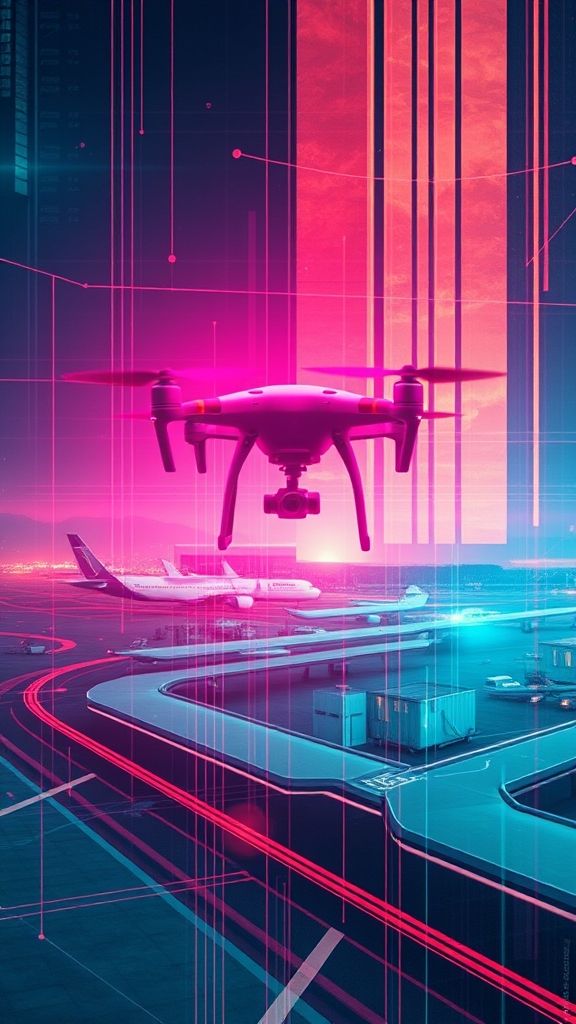Softbank Lands 5375 Billion Robot Empire Amid Push For Revolutionary Physical Ai
SoftBank Group’s $5.375 billion acquisition of ABB’s Robotics division solidifies its …
10. October 2025

A recent incident involving a drone hovering at 75 feet near San Diego International Airport’s active runway has sparked confusion and raised concerns about the coordination gaps between police operations and air traffic control systems. The Autel Robotics EVO 2 enterprise drone, caught on video by plane-spotting YouTube channel Airline Videos during a live broadcast on August 27, 2025, created a dangerous close call with incoming passenger aircraft.
The footage shows the drone hovering in place before suddenly climbing even higher, nearly entering the flight path for incoming aircraft. Moments later, a Southwest Airlines passenger jet passed just a few hundred feet above the hovering drone as it prepared to land. The incident highlights the growing problem of unauthorized drone activity near airports, with San Diego International Airport emerging as a hotspot for such operations.
Air traffic control recordings captured by VASAviation, a YouTube channel run by corporate pilot and certified flight instructor Victor Atienza Sanchez, reveal that controllers initially referred to the aircraft as a “police drone” before later calling it an “unauthorized drone.” The shifting terminology exposed dangerous uncertainty about whether the operation was legitimate law enforcement activity or an illegal flight.
The Autel EVO 2 visible in the footage is an older model drone and still has instructional stickers attached its arms. This detail is significant because older Autel EVO 2 models (V1 and V2) do not have built-in Remote ID and require an external broadcast module to comply with FAA regulations that have been fully enforced since March 2024.
No external Remote ID module is visible on the drone in the video footage, suggesting a clear violation of federal law. Additionally, no FAA registration number can be seen on the aircraft, though the video quality and angles don’t provide a perfect view of all sides of the drone.
The incident highlights the growing coordination gaps as police drone programs expand nationwide. The FAA granted 214 Drone as First Responder program approvals in 2025, with law enforcement agencies deploying drones from automated docking stations that can reach emergency scenes in under 60 seconds. However, this rapid expansion has created challenges for air traffic control systems to keep up.
The Autel EVO 2 enterprise model visible in the footage is commonly used by law enforcement and commercial operators. If this was a legitimate police operation, the lack of coordination with ATC represents a serious failure in operational protocols. If it was unauthorized, the fact that ATC initially assumed it was police equipment suggests dangerous confusion in the system.
DroneUp CEO Tom Walker has warned that without improved coordination, “we are going to have a catastrophic event.” His warning followed a drone collision with a rescue helicopter during Texas flood operations that forced the crew to land and halted life-saving efforts.
The San Diego incident exemplifies Walker’s concerns. Whether the drone was police or unauthorized, the ATC confusion demonstrates how the system breaks down when proper coordination doesn’t occur. Federal response and investigation are still underway, but it remains unclear whether the operator has been identified or charged with any violations.
San Diego International Airport sits in Class B controlled airspace where drone operations absolutely require FAA authorization through the LAANC system—authorization that would certainly be denied for flights at 75 feet near an active runway. The airport’s concentration of military and commercial aviation makes unauthorized drone operations particularly dangerous.
Flying a drone in this location without authorization could result in civil penalties exceeding $30,000. The FAA proposed $341,413 in civil penalties against 27 drone operators in 2024 for various violations, with individual fines reaching $32,700 for interfering with law enforcement operations.
The incident highlights the need for improved coordination between police operations and air traffic control systems. Drone incursions near airports have surged 25.6% in the first quarter of 2025, with 411 incidents reported compared to 327 during the same period in 2024. San Diego International Airport has emerged as a new hotspot for such operations.
The FAA’s approval of over 200 Drone as First Responder programs this year has created challenges for air traffic control systems to keep up. These programs save lives, but they also create coordination gaps if not properly managed.
DroneUp’s CEO warned we’re headed for a catastrophic event. Looking at the footage—a drone hovering 75 feet below landing aircraft while ATC scrambles to figure out who’s flying it—it’s hard to argue he’s wrong. The incident is exactly what experts have been warning about, highlighting the need for improved coordination and compliance with FAA regulations.
The broader context is even more troubling. SkySafe detected 34 unauthorized flights near San Diego’s airports in a single month last year, with one drone repeatedly climbing to nearly 9,000 feet. That’s not ignorance—that’s systematic violation. And with DJI eliminating geofencing in January 2025, the responsibility for compliance has shifted entirely to operators.
Some will respect that responsibility. Others, clearly, will not. The incident highlights the need for increased awareness and education about drone safety and regulations near airports. As police drone programs continue their rapid growth, it’s essential to address these coordination gaps and ensure that all drones flying in such areas are properly registered and equipped with Remote ID technology.
The San Diego incident serves as a warning to drone operators, air traffic control systems, and law enforcement agencies to prioritize coordination and compliance. Without it, the risk of catastrophic events will continue to grow.